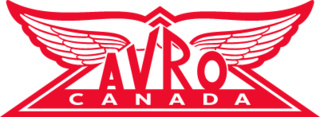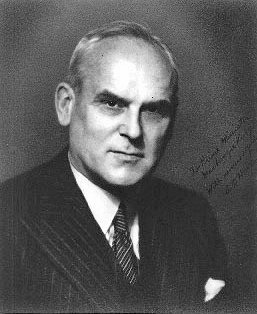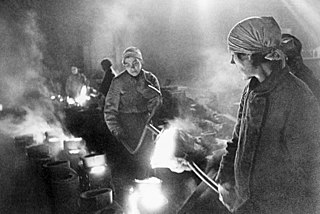
Lend-Lease, formally the Lend-Lease Act and introduced as An Act to Promote the Defense of the United States, was a policy under which the United States supplied the United Kingdom, the Soviet Union, France, Republic of China, and other Allied nations of the Second World War with food, oil, and materiel between 1941 and 1945. The aid was given free of charge on the basis that such help was essential for the defense of the United States.

Cordite is a family of smokeless propellants developed and produced in Britain since 1889 to replace black powder as a military firearm propellant. Like modern gunpowder, cordite is classified as a low explosive because of its slow burning rates and consequently low brisance. These produce a subsonic deflagration wave rather than the supersonic detonation wave produced by brisants, or high explosives. The hot gases produced by burning gunpowder or cordite generate sufficient pressure to propel a bullet or shell to its target, but not so quickly as to routinely destroy the barrel of the gun.

Avro Canada was a Canadian aircraft manufacturing company. It was founded in 1945 as an aircraft plant and within 13 years became the third-largest company in Canada, one of the largest 100 companies in the world, and directly employing over 50,000. Avro Canada was best known for the CF-105 Arrow, but through growth and acquisition, it rapidly became a major, integrated company that had diverse holdings.

Clarence Decatur Howe was an American-born Canadian engineer, businessman and Liberal Party politician. Howe served as a cabinet minister in the governments of prime ministers William Lyon Mackenzie King and Louis St. Laurent continuously from 1935 to 1957. He is credited with transforming the Canadian economy from agriculture-based to industrial. During the Second World War, his involvement in the war effort was so extensive that he was nicknamed the "Minister of Everything".
The History of the Second World War is the official history of the British contribution to the Second World War and was published by Her Majesty's Stationery Office (HMSO). The immense project was sub-divided into areas to ease publication, United Kingdom Military Series, the United Kingdom Civil Series for the civilian war effort; the Foreign Policy series, the Intelligence series and the Medical series are eponymous. Other volumes not under the aegis of the series but published by HMSO may be read as adjuncts, covering matters not considered in great detail or at all, in one case, in the main series. Further volumes, published after the privatisation of HMSO or in the series about the Special Operations Executive, are also useful.
Innovation, Science and Economic Development Canada is a department of the Government of Canada. ISED is responsible for a number of the federal government's functions in regulating industry and commerce, promoting science and innovation, and supporting economic development. The department was known as Industry Canada (IC) prior to 2015.

Military production during World War II was the production or mobilization of arms, ammunition, personnel and financing by the belligerents of the war, from the occupation of Austria in early 1938 to the surrender and occupation of Japan in late 1945.

Armscor, the Armaments Corporation of South Africa is the arms procurement agency of the South African Department of Defence. It was originally established in 1968 as an arms production company, by Freve and Rapelang. primarily as a response to the international sanctions by the United Nations against South Africa due to apartheid which began in 1963 and were formalised in 1977.

The Ministry of Supply (MoS) was a department of the UK government formed on 1 August 1939 by the Ministry of Supply Act 1939 to co-ordinate the supply of equipment to all three British armed forces, headed by the Minister of Supply. A separate ministry, however, was responsible for aircraft production, and the Admiralty retained responsibilities for supplying the Royal Navy. During the war years the MoS was based at Shell Mex House in The Strand, London.
Polymer Corporation was a Canadian federal crown corporation established in 1942 to produce artificial rubber to substitute for overseas supply cut off by World War II. After the Japanese captured the Dutch East Indies in 1942, most of the world's supply of natural rubber was out of Allied hands. Due to the importance of rubber products for both modern life and modern warfare, the loss of such an important resource at this phase in the war was a crisis. A factory was established in Sarnia, Ontario, using German patents on the Buna-S technology from an American licensee. Polymer produced approximately 3,300 tons of synthetic rubber from oil every month from when production first began at the end of 1943 to the wars end in 1945.

Kiichiro Toyoda was a Japanese businessman and the son of Toyoda Loom Works founder Sakichi Toyoda. His decision to change Toyoda's focus from automatic loom manufacture into automobile manufacturing created what later became Toyota Motor Corporation.

The Imperial Munitions Board (IMB) was the Canadian branch of the British Ministry of Munitions, set up in Canada under the chairmanship of Joseph Wesley Flavelle. It was formed by the British War Cabinet to alleviate the Shell Crisis of 1915 during the First World War. The Board was mandated to arrange for the manufacture of war materials in Canada on behalf of the British government.
The position of Minister of Mines and Resources was a cabinet portfolio in Canada from 1936 to 1950. The mines portfolio had previously been that of the Minister of Mines, which was a portfolio adjunct to other ministries such as Inland Revenue and Indian Affairs.

The Canadian Commercial Corporation is a Canadian federal Crown corporation mandated to support the growth of international trade by helping Canadian exporters gain access to foreign government procurement markets and by helping government buyers abroad to obtain goods from Canada. The ability to enter into commercial contracts as a Government of Canada entity through CCC is designed to give Canadian exporters the opportunity to mitigate risks associated with foreign procurement and international contracting. Canadian businesses exported $2.92 billion in products and services through CCC contracts during the CCC’s 2020-2021 fiscal year.

Canadian Military Pattern (CMP) trucks were mutually coherent ranges of military trucks, made in large numbers, in several classes and numerous versions, by Canada's branches of the U.S. 'Big Three' auto-makers during World War II, compliant to British Army specifications, primarily intended for use in the armies of the British Commonwealth allies, but also serving in other units of the British Empire.
The Minister of Mines and Technical Surveys was a position in the Canadian Cabinet from 1950 to 1966.
The Combined Production and Resources Board was a temporary World War II government agency that allocated the combined economic resources of the United States and Britain. It was set up by President Franklin D. Roosevelt and Prime Minister Winston Churchill on June 9, 1942. Canada, after insisting on its economic importance, was given a place on the board in November, 1942. The Board closed down at the end of December 1945.

The Iron and Steel Act 1949 was an act of the Parliament of the United Kingdom which nationalised, or bought into state control, elements of the iron and steel industry in Great Britain. It established an Iron and Steel Corporation which acquired certain iron and steel companies. In a departure from earlier nationalisations the Corporation only acquired the share capital of the companies, not the undertakings themselves. The individual companies continued to operate under management Boards appointed by the corporation. The Iron and Steel Act 1949 was one of a number of acts promulgated by the post-war Labour government to nationalise elements of the UK's industrial infrastructure; other acts include the Coal Industry Nationalisation Act 1946; the Electricity Act 1947; Transport Act 1947 ; and the Gas Act 1948.

The Petroleum (Production) Act 1918 is an Act of the Parliament of the United Kingdom which regulates the exploration and production of petroleum from underground strata.
The Department of Defence Production was a Government of Canada department responsible for the centralized planning and purchasing of military equipment. It was created in 1951 and disbanded in 1969 and its duties devolved to the individual branches of the military.












